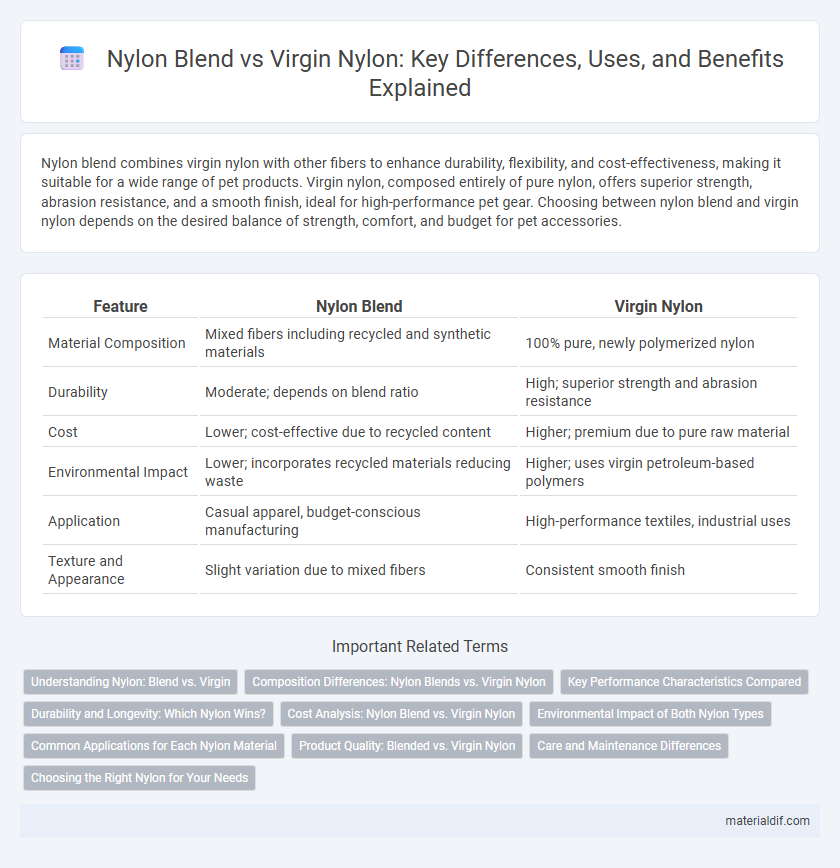Nylon blend combines virgin nylon with other fibers to enhance durability, flexibility, and cost-effectiveness, making it suitable for a wide range of pet products. Virgin nylon, composed entirely of pure nylon, offers superior strength, abrasion resistance, and a smooth finish, ideal for high-performance pet gear. Choosing between nylon blend and virgin nylon depends on the desired balance of strength, comfort, and budget for pet accessories.
Table of Comparison
| Feature | Nylon Blend | Virgin Nylon |
|---|---|---|
| Material Composition | Mixed fibers including recycled and synthetic materials | 100% pure, newly polymerized nylon |
| Durability | Moderate; depends on blend ratio | High; superior strength and abrasion resistance |
| Cost | Lower; cost-effective due to recycled content | Higher; premium due to pure raw material |
| Environmental Impact | Lower; incorporates recycled materials reducing waste | Higher; uses virgin petroleum-based polymers |
| Application | Casual apparel, budget-conscious manufacturing | High-performance textiles, industrial uses |
| Texture and Appearance | Slight variation due to mixed fibers | Consistent smooth finish |
Understanding Nylon: Blend vs. Virgin
Nylon blend combines virgin nylon with other fibers, enhancing durability, flexibility, and cost-effectiveness for diverse applications. Virgin nylon consists of pure polymer fibers, offering superior strength, abrasion resistance, and chemical stability ideal for high-performance uses. Understanding the distinctions aids in selecting the right nylon type tailored for specific industrial or consumer needs.
Composition Differences: Nylon Blends vs. Virgin Nylon
Nylon blends combine nylon fibers with other materials such as spandex, polyester, or cotton to enhance flexibility, durability, and moisture-wicking properties, whereas virgin nylon consists of 100% pure, untreated nylon polymer offering superior strength and elasticity. The varying fiber composition in nylon blends affects the fabric's texture, stretch, and breathability, making them suitable for specialized applications like activewear or upholstery. Virgin nylon's uniform molecular structure provides consistent performance in high-stress environments, making it ideal for technical textiles and industrial uses.
Key Performance Characteristics Compared
Nylon blend fibers offer enhanced durability and flexibility compared to virgin nylon, making them ideal for applications demanding high abrasion resistance and stretch recovery. Virgin nylon exhibits superior tensile strength and chemical resistance due to its pure polymer composition, which is beneficial for heavy-duty industrial uses. The choice between nylon blend and virgin nylon depends on balancing performance characteristics with cost-efficiency in specific manufacturing processes.
Durability and Longevity: Which Nylon Wins?
Nylon blend fabrics typically incorporate other fibers to enhance specific properties, but in terms of durability and longevity, virgin nylon stands out due to its pure composition and consistent molecular structure, providing superior resistance to wear, abrasion, and environmental stress. Virgin nylon fibers maintain their tensile strength and elasticity longer than blended counterparts, resulting in extended product lifespan. Blends may offer cost savings or specialized performance features but often compromise the intrinsic durability that 100% virgin nylon delivers in industrial and consumer applications.
Cost Analysis: Nylon Blend vs. Virgin Nylon
Nylon blend fabrics typically offer a more cost-effective solution by combining nylon with other fibers, reducing overall material expenses compared to 100% virgin nylon. Virgin nylon, known for its superior strength and durability, generally commands a higher price due to its pure polymer content and manufacturing complexity. Cost analysis reveals that while virgin nylon ensures premium performance, nylon blends deliver a balanced approach by optimizing price without severely compromising quality.
Environmental Impact of Both Nylon Types
Nylon blend fabrics typically incorporate recycled fibers, reducing reliance on fossil fuels and decreasing overall carbon emissions compared to virgin nylon, which is made from 100% petrochemical sources. Virgin nylon production generates higher greenhouse gas emissions and consumes more energy due to the extraction and polymerization of raw materials. Choosing nylon blends contributes to less environmental pollution and supports circular economy principles by utilizing post-consumer or industrial waste.
Common Applications for Each Nylon Material
Nylon blend fabrics are commonly used in activewear, outdoor gear, and upholstery due to their enhanced durability, flexibility, and moisture-wicking properties. Virgin nylon finds frequent application in automotive parts, industrial components, and high-performance textiles where superior strength and resistance to abrasion are critical. Both materials serve distinct roles, with nylon blends favored for comfort and adaptability, while virgin nylon is preferred for structural integrity and longevity.
Product Quality: Blended vs. Virgin Nylon
Virgin nylon offers superior product quality due to its pure polymer composition, ensuring enhanced strength, durability, and consistent texture. Nylon blends, incorporating recycled or other synthetic fibers, often compromise on tensile strength and resilience but provide cost-effectiveness and improved elasticity. Choosing virgin nylon guarantees higher wear resistance and longevity, critical for performance-intensive applications.
Care and Maintenance Differences
Nylon blend fabrics often require gentler care due to the mixed fibers, typically needing lower washing temperatures and delicate cycles to prevent damage or shrinkage, unlike virgin nylon which is more resilient and can withstand higher heat and more vigorous washing. Virgin nylon resists abrasion and moisture better, making it easier to maintain with standard machine washing and drying without losing strength or shape. Proper care for nylon blends includes avoiding high heat drying and harsh detergents to prolong fabric life, whereas virgin nylon tolerates more robust cleaning methods and dries quickly, reducing mildew risks.
Choosing the Right Nylon for Your Needs
Nylon blend fabrics combine nylon with other fibers such as polyester or spandex, offering enhanced durability, flexibility, and cost-effectiveness compared to virgin nylon. Virgin nylon, made from 100% pure nylon polymer, provides superior strength, abrasion resistance, and a smooth finish ideal for high-performance applications. Selecting the right nylon depends on specific requirements like budget, durability, stretch, and application environment to ensure optimal performance and longevity.
Nylon Blend vs Virgin Nylon Infographic

 materialdif.com
materialdif.com